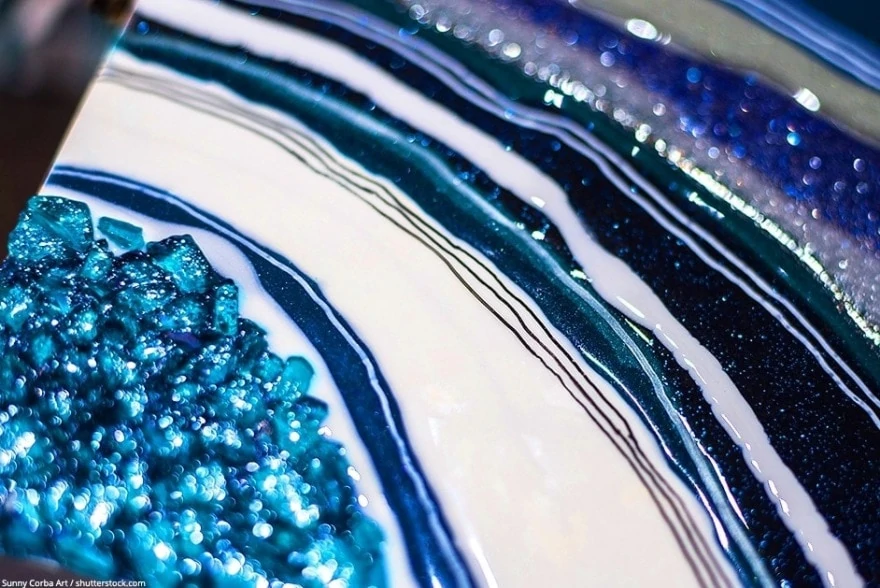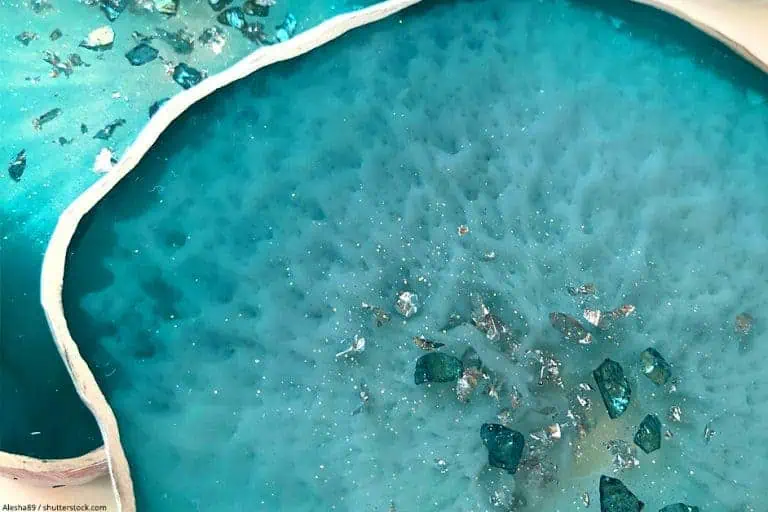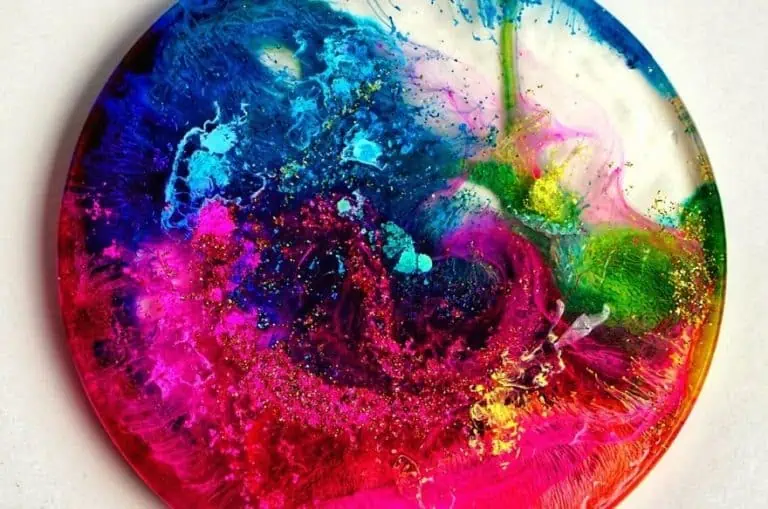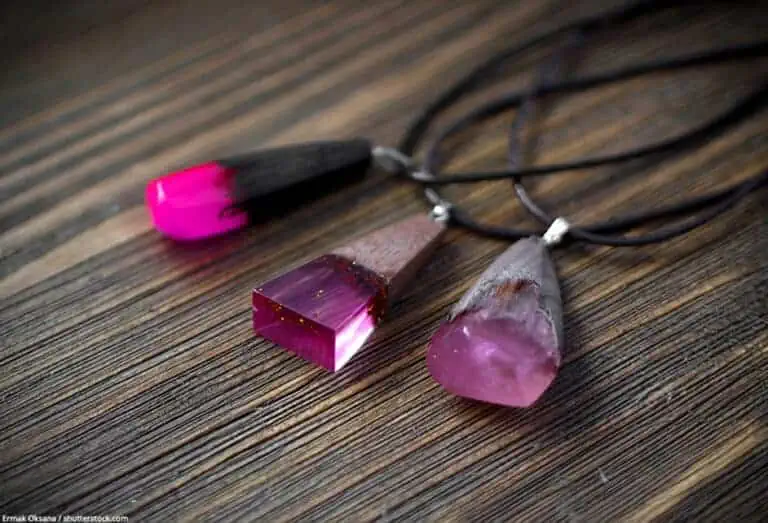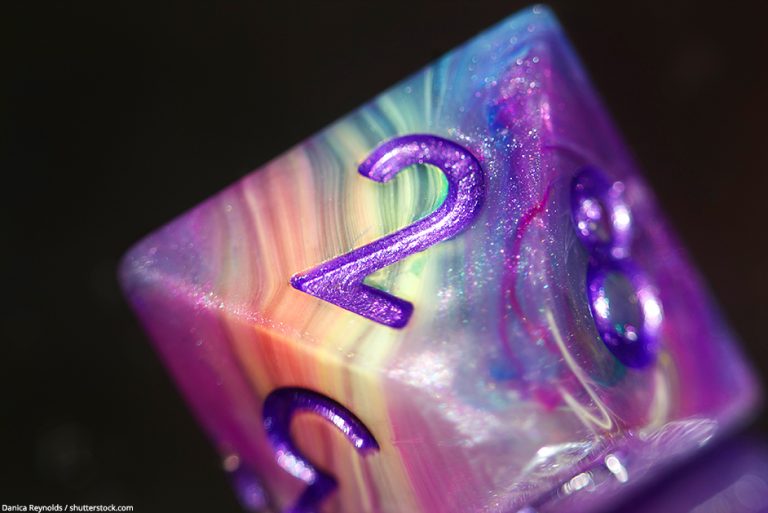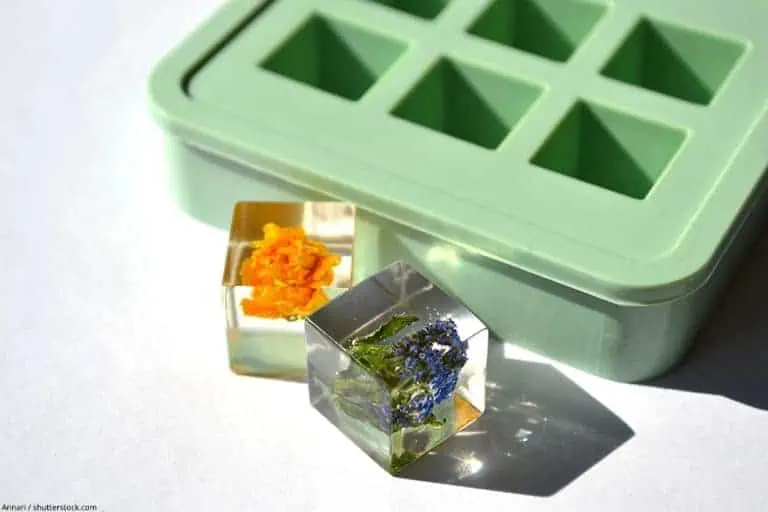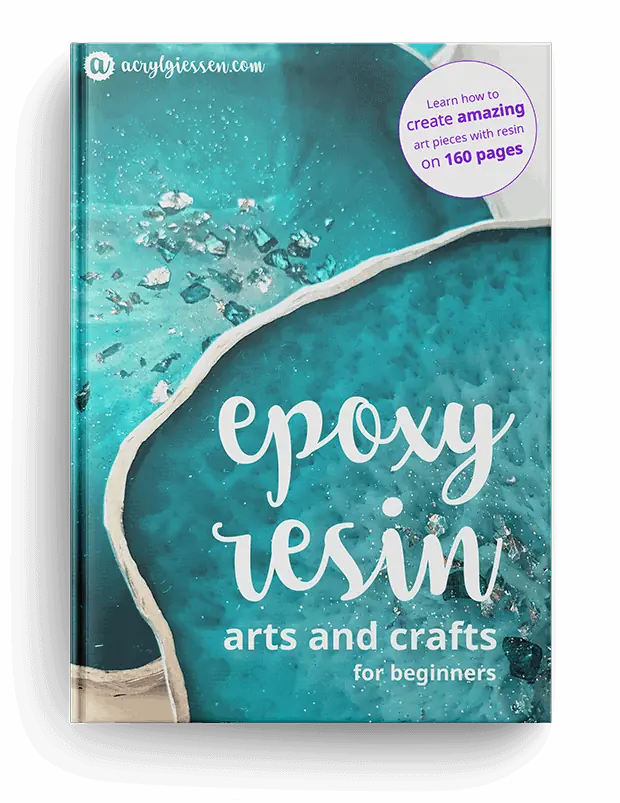Best Epoxy Resin – Find the perfect Resin for all your Projects
This post may contain affiliate links. We may earn a small commission from purchases made through them, at no additional cost to you.
Parallel to the increase in popularity of epoxy resin as a material for creative handicraft and art projects, the range of different manufacturers and products has multiplied over the last few years. Therefore, it is no longer easy to choose the most suitable epoxy resin from this wealth of options. With our following guide we would like to enable you to buy the epoxy resin that is perfectly suited for your individual project.
Table of Contents
- 1 Best Epoxy Resin – what you should consider
- 2 What are the differences between available Types of Resin?
- 3 Best Epoxy Resin for Epoxy Resin and River Table
- 4 Best Resin for Resin Art and Resin Paintings
- 5 Best Epoxy Resin for Floor Coatings
- 6 Best Resin for Epoxy Resin Jewelry
- 7 Which is the best UV Resin?
- 8 The ideal Epoxy Resin for Molding / Resin Casting
- 9 Things to know about Laminating Resin / Epoxy Resin
- 10 The Viscosity of Casting Resins: Everything about Viscosity
- 11 Epoxy Resin: Information on Processing Time
- 12 The Curing Times of the different Resins
- 13 The Hardness of Epoxy Resin Surfaces
- 14 The UV Resistance of various Epoxy Resin Products
- 15 Susceptibility to Bubble Formation
- 16 The Heat Compatibility of Epoxy Resin
- 17 Coloring Epoxy Resin
- 18
- 19 Information on weighing and mixing Resin
- 20 Saving sticky Resin Surfaces
- 21 The right Painting Surface for Resin Art
- 22 Buying Epoxy Resin: Frequently asked Questions and Answers on the Topic
Best Epoxy Resin – what you should consider
The great increase in the range of products and the number of fans of this exciting craft has also ensured that many quite cheap products are now available on the market. At first sight, these may seem tempting in terms of price, but they can also cause a lot of frustration after laboriously done work if the quality is poor. We therefore recommend that you always prefer to use the high-quality products of well-known brand manufacturers. As a rule, the additional financial outlay due to the better quality pays off absolutely. Nevertheless, you can also buy a not so high-quality epoxy resin at a low price, so that you can gain experience directly after starting this hobby without any major financial expenditure.
What are the differences between available Types of Resin?
Basically, a distinction is made between the different types of resin between the designations epoxy resin and cast resin. It is not uncommon that these two terms are used more or less synonymously. This may also be due to the fact that they are basically the same material. However, on closer inspection, cast resins and epoxy resins do differ in their specific properties and are therefore differently optimal for different applications.
Casting Resins
- have a rather thin consistency before curing (they are therefore low viscosity)
- can be processed over long periods of time
- therefore cure correspondingly slowly
- can be processed with a thicker layer height per casting process
- must be mixed with different ratios
Epoxy Resins / Laminating Resins
- initially have a relatively viscous, tough consistency (therefore they are called highly viscous)
- have only relatively short processing times
- cure relatively quickly
- can only be applied in a rather thin layer (very limited layer thickness per casting process)
- are stirred with simple mixing ratios
Best Epoxy Resin for Epoxy Resin and River Table
The production of an Epoxy Resin Table on your own has become a worldwide trend. From suitable wood and epoxy you can make such a table according to your artistic taste. However, you should only approach a project of this size with the experience of smaller projects with epoxy resin. In addition, the preparation of the wooden parts to be used requires a lot of time. Depending on the planned tabletop format, you may need up to 10 kg of epoxy resin for a 5 cm thick tabletop. The thickness of the tabletop also determines which casting resin you can use. After all, not all casting resins can be processed without problems in layer thicknesses of the necessary order of magnitude.
Beginners often make the mistake that they simply want to use a cheap resin from the trade to build an Epoxy River Table themselves. Just as often, however, it happens that wood, resin and work place are negatively affected due to the heat development associated with the exothermic reaction. In order to prevent damage and dangers of this kind, it is therefore better to have both the necessary patience and the necessary investment in a sufficiently high-quality casting resin for such a project. However, even with high-quality products, you will sometimes have to carefully pour several thin layers on top of each other. One layer of the specially suited product must always harden for several hours before the next layer can be poured over it.
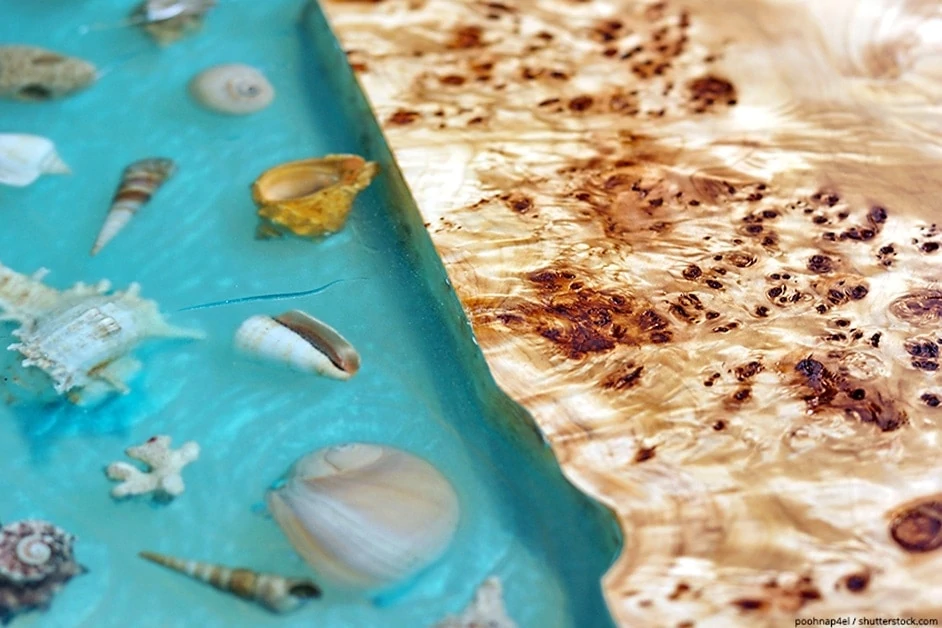
To choose the right material for an Epoxy Table, you should pay attention to the following properties:
- with the selected epoxy a layer height of 5 cm should be feasible
- the heat development should be as low as possible, so that larger quantities can also be processed at once
- a longer pot life is advantageous, as the air bubbles can rise and escape longer
- with an effective UV protection your projects are better protected against long-term yellowing
Our Recommendation: PRO MARINE Crystal Clear Bar Top Epoxy Resin Coating
PRO MARINE Crystal Clear Bar Top Epoxy Resin Coating is a premium, high-gloss resin designed for bar tops, tabletops, and other surfaces requiring a durable, crystal-clear finish. This epoxy resin offers excellent UV resistance, preventing yellowing and maintaining its clarity over time. With its self-leveling properties, it ensures a smooth, glass-like surface that enhances the natural beauty of embedded materials, such as wood, photos, or memorabilia. Easy to use with a 1:1 mixing ratio, PRO MARINE’s epoxy resin is ideal for both DIY enthusiasts and professionals looking to create stunning, long-lasting surfaces that are resistant to scratches, stains, and moisture.
- High-quality crystal clear Table Top Epoxy
- 100% Solid Material with no VOC and solvent additives
- When mixed using a 1:1 ratio
Best Resin for Resin Art and Resin Paintings
Meanwhile there are a multitude of possible art projects with epoxy, which are summarized under the generic term Resin Art. There are hardly any limits to creativity in the realization of versatile decoration and art projects: Whether it is a matter of cast paintings made of colored epoxy resin on a wooden painting ground, modern jewelry made of resin or artificially produced geodes or resin coasters – these types of projects always involve the casting of rather thin layers of resin. In order to achieve an attractive color design in this type of project, your chosen resin must not be too thin. Otherwise the added colors would mix too quickly and the desired color structure would not be achieved.
Especially for artistically high-quality purposes, there are corresponding special products that meet the needs of demanding epoxy resin artists well. It is important that as far as possible no solvents are used, that only few odour emissions are produced during processing and that no volatile organic compounds are created. Furthermore, most high-quality epoxy resins are already equipped with a very effective UV filter. So you can be sure that the objects you produce with it will not yellow under UV light later on. The fact that epoxy is almost always subject to a certain clouding and yellowing of its transparency, which is initially similar to glass, is a fact that can hardly be prevented. If you add colors to the resin you use, however, a slight yellowing is usually only partially noticeable.
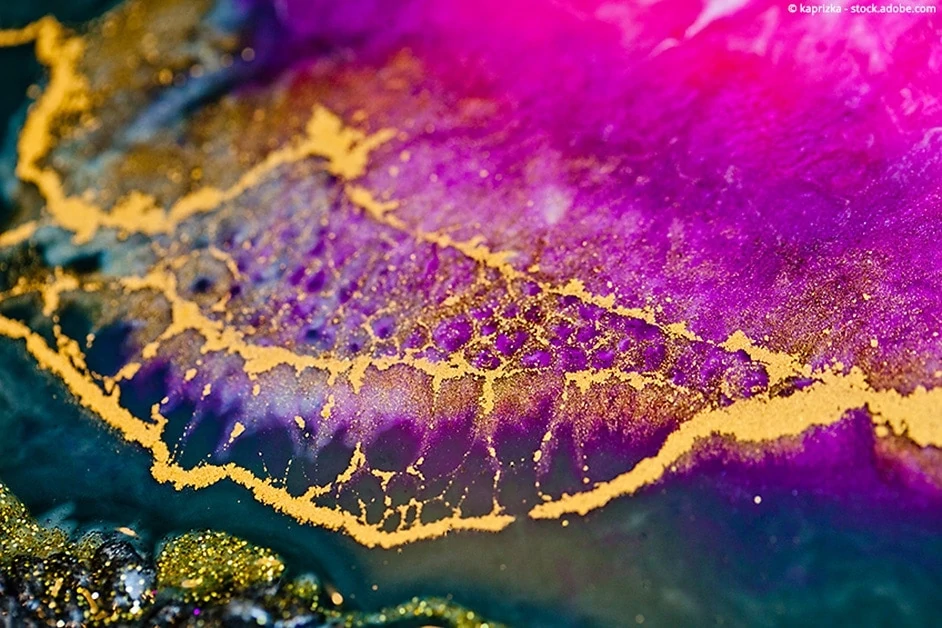
These factors are particularly important when choosing epoxy resin for artistic projects:
- a rather viscous resin (medium or high viscosity) ensures good color separation
- this category includes, for example, the “laminating resins” specially developed for hard-wearing coatings
- in order to have sufficient time to cast a painting or artwork, the processing time should be sufficiently long (for example, about 30 minutes)
- UV protection contained in the epoxy protects the finished artwork from yellowing and maintains its shine
The best Resin for Crafting your Resin Paintings: Pro Marine ProArt Resin
Pro Marine ProArt was developed with the aim of creating a resin that is as easy to handle as possible without toxic substances. Therefore, this epoxy resin does not contain any solvents and therefore hardly evaporates. This does not mean, however, that you should throw the usual safety measures overboard during processing, such as sufficient ventilation or protective clothing. ProArt Resin already contains a high-quality UV filter that effectively protects your cured artwork from yellowing. The special consistency prevents undesired color mixing of partial quantities with different color pigments.
- Specifically designed for art projects, excellent color stability
- Very easy to use with 1 : 1 mixing ratio, 100% solids, hard-shell finish
- High gloss and crystal clear, your all-seal solution, excellent air release
Best Epoxy Resin for Floor Coatings
Nowadays more and more floors in living and working areas are sealed with hard-wearing epoxy resin. The advantageous properties of this modern material have been proven in practice both in living rooms and garages. The possibilities are hardly limited: Whether in the cellar, kitchen, bathroom or living room or bedroom – epoxy can be used for a wide variety of floors as a glossy finish and protective layer. Even high-quality wooden floors can be protected from scratches and moisture.
However, an important point is the material’s balance between strength and elasticity: the epoxy applied to the floor as a protective layer should be very hard and resistant on the one hand after curing. On the other hand, it should also have a certain degree of elasticity under certain loads in order to be able to cushion them. Also in terms of processing, the products must be as easy to handle as possible. Possible air bubbles should ideally be able to detach themselves from the material almost by themselves and rise. Most epoxy resins sold as floor coatings are available in a wide range of already tinted colors. This not only ensures color accuracy in accordance with the RAL standard, but also eliminates an otherwise tedious step during application. If you would like more information on this topic, you will find much more clearly prepared information in our guide to the topic of self-made epoxy resin flooring, including detailed instructions on the exact procedure.
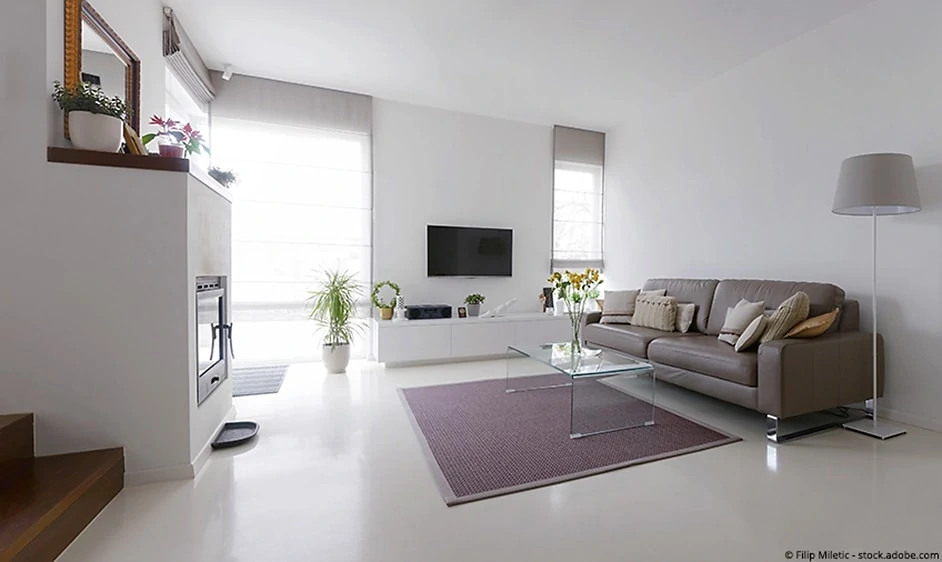
You should consider these factors if you want to buy epoxy resin for a floor coating:
- the chosen resin should be self-levelling to ensure that the floor covering is as even as possible
- the consistency of the product should allow air bubbles to escape independently
- to enable larger areas to be treated, the product should have a sufficiently long working time
- an already contained UV-protection prevents yellowing and color change effects otherwise occurring under solar radiation
- both abrasion resistance and impact strength should be given
Our Recommendation: Crystalac Extreme Protection Water Based Polyurethane
Crystalac Extreme Protection Water Based Polyurethane offers a high-quality, clear gloss finish designed to protect and enhance the beauty of various surfaces. This gallon-sized product is perfect for both residential and commercial applications, providing a durable and long-lasting protective coat. Its water-based formula ensures easy application and cleanup, while being environmentally friendly. Ideal for wood, furniture, floors, and more, Crystalac delivers a professional-grade finish that resists scratches, stains, and yellowing, ensuring your projects remain pristine over time.
- Superior durability with resistance to scratches, stains, and yellowing
- User-friendly application
Best Resin for Epoxy Resin Jewelry
With suitable molds made of silicone you can cast your own Epoxy Resin Jewelry from resin relatively easily. There are hardly any limits to your creativity, as you can use either clear or colored resin. The combination of resin with different materials such as wood is also possible for particularly attractive creations. You can also cast objects in resin and thus permanently preserve them. In contrast to other areas of application of resin, this type of craftwork does not depend so much on the possibility of being able to process large quantities of material in an appropriate layer thickness. Rather, factors such as processability, UV protection and, when using several colors, the color separation of the different colors are more important. In addition, the product used should cure as clear as possible if the objects cast in it are to be perfectly visible later. So pay attention to these properties if you want to buy epoxy for the production of jewelry. When you look at the jewelry items you make, you will see that this careful selection of epoxy is worthwhile for this purpose.
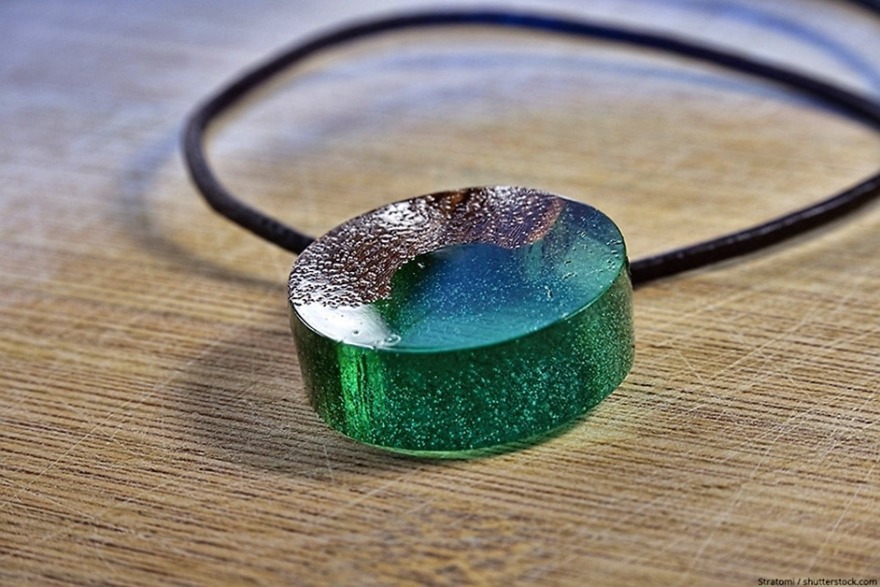
You should keep these things in mind when casting jewelry from epoxy resin:
- only if the selected resin hardens really hard, your jewelry will not get scratches
- during casting, trapped air bubbles should, if possible, escape from the material by themselves or be removed with a Bunsen burner for a crystal-clear quality
- only a high-quality UV protection protects your jewelry from yellowing and other color changes
ProMarine ProArt Resin: Our recommendation for Resin Jewelry
ProMarine ProArt Resin is a very versatile all-round resin. This resin impresses not only with a good price/performance ratio, but also with an optimal suitability for the production of aesthetic jewelry made of resin. The resin hardens particularly crystal clear when processed carefully and its consistency allows good color separation of differently colored resin quantities.
- Specifically designed for art projects, excellent color stability
- Very easy to use with 1 : 1 mixing ratio, 100% solids, hard-shell finish
- High gloss and crystal clear, your all-seal solution, excellent air release
Which is the best UV Resin?
UV resin is a special epoxy resin that is already mixed ready for further processing and can therefore be used without lengthy mixing. The possible processing time of UV resin is so long because this special resin only hardens when exposed to UV light. However, if it is specifically exposed to UV light, the curing process is all the faster and the UV resin becomes completely hard within a short period of time, from a few seconds to a few minutes. This makes this material particularly suitable for small-format casting molds and smaller sealing surfaces, where the curing process has to be particularly fast. In this respect, its use is particularly conceivable in the field of jewelry production as well as for repairs and other applications in the home.
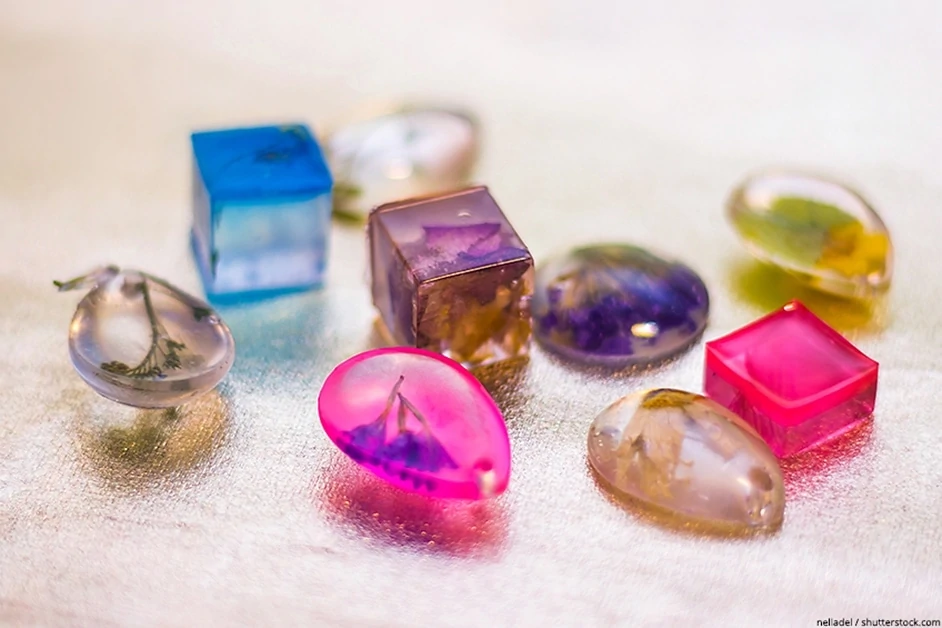
You should consider these points when buying UV resin:
- whether it should be thin or thick depends on the respective application
- if the trapped air bubbles do not already escape by themselves, you should remove them by carefully heating them with a Bunsen burner
- for optimal curing you need correspondingly intensive UV light, for this there are special UV lamps
- more intensive odour emissions can occur during processing than when using conventional resin
Our Recommendation: UV Resin from Limino
The high quality and a crystal clear curing structure are the two main advantages of using Limino UV resin. Under UV light this UV resin cures completely after about 1 to 2 minutes and also the air bubbles that might form can be removed relatively easily. Since Limino resin is not too expensive for the quality offered, we can recommend it for first attempts with UV resin.
- High-quality UV Resin from Japan, developed with non-toxic materials
- High yellowing resistance, very hard surface after curing, anti-scratch, anti-stain
- UV epoxy resin with self-leveling properties cures a smooth crystal clear, glassy finish
If you start from scratch with UV Resin, take a look at this UV Resin set, which contains everything you need for your start into working with UV curing Resin:
- Very good transparency and excellent hard glassy finish after curing.
- 15 colors,10 molds and 54 different shapes and back bezels
- UV lamp with USB cable included
The ideal Epoxy Resin for Molding / Resin Casting
molding with epoxy resin requires resin products with completely different specific properties than the coating of surfaces or the production of paintings in the sense of creative resin art. In molding casting, higher layers usually have to be cast. Therefore you have to buy a slower curing resin for this purpose, so that during the curing process too much heat is not released at once due to the exothermic reaction. Furthermore, the air bubbles can only escape from the thicker layers if the resin used does not cure too quickly. Conventional laminating resin should therefore not actually be cast thicker than a maximum of 2 or 3 cm. For thicker layers, it is better to buy a resin specially developed for these applications.
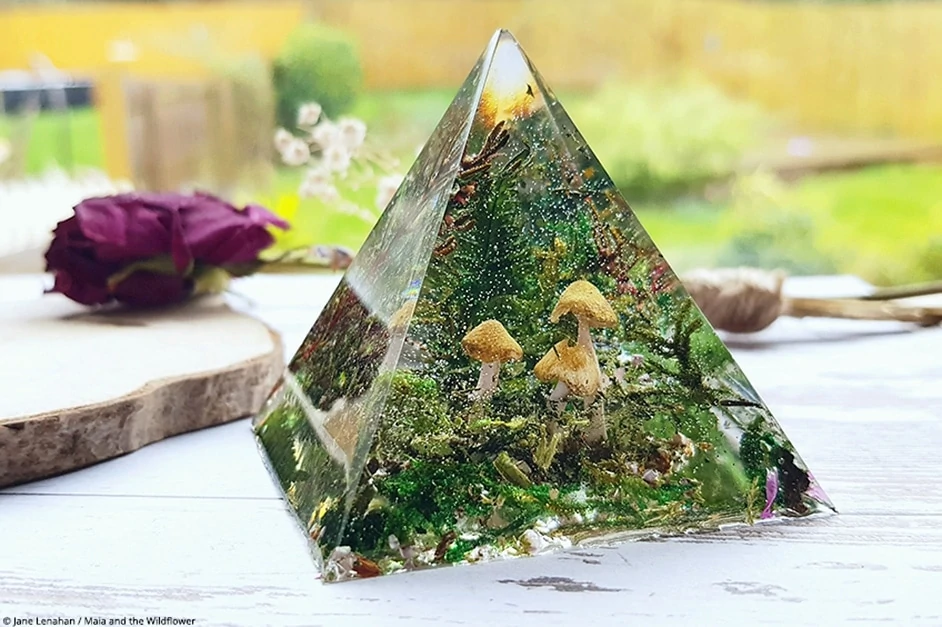
Pay attention to the following instructions if you want to buy epoxy resin for molding casting:
- Casting resins are usually of low viscosity, i.e. of low viscosity consistency
- excessive heat development during curing is prevented by a long open time
- you should be able to pour layers up to about 5 cm high without any problems
- When molding, the epoxy resin used is often not colored, but left transparent for the casting of objects in the resin. Therefore, a corresponding UV filter should be present in the casting resin used.
Our Product Recommendation: INCREDIBLE SOLUTIONS Pourable Plastic Resin
Incredible Solutions casting resin meets the highest quality standards. With the special casting resin Liquid Glass casting molds with a height of up to 2″ can be poured out at once. The crystal clear resin offers a processing time of up to 24 hours, which means that even trapped air bubbles can escape almost completely on their own.
- 2 : 1 mix ratio by volume (100 A to 44 B by weight)
- Thick pours up to 2" per application, low viscosity and long working time
- Super clear results, compatible with pigments and dyes
Things to know about Laminating Resin / Epoxy Resin
As a material for a wide range of applications, epoxy resin is generally characterised by its unique durability, special resistance on a chemical level and special strength when bonding objects together. Since epoxy resin itself is not very porous, it is ideally suited as a protective coating for various more sensitive materials. In order to make the most of the advantages of the various casting resins for your particular product, you should always follow the manufacturer’s instructions on the mixing ratio as closely as possible. In this way you will achieve the best results with this material, which is usually mixed in a two-component process. So if this is your first experience with a new product or brand, you should first study the instructions on the packaging very carefully.
For many products, the so-called pot life after mixing the two components with each other is only about one hour. Therefore, it is essential that you prepare the materials and tools necessary for later processing in advance so that you do not lose too much time later. Once the pot life has expired, the material can heat up considerably. In addition, after a certain point in time, the material hardens very quickly. There are products where the open time is only a few minutes, but it can take a few days until the material is completely hardened.
The Viscosity of Casting Resins: Everything about Viscosity
In contrast to many epoxy resins, special casting resins are relatively thin-bodied, which is why they are also called low-viscosity resins. Such casting resins usually cure rather slowly and therefore do not heat up as much as fast curing epoxy resins. Therefore, you can also cast thicker layers with casting resins. However, problems can occur when casting resins are to be used for coating surfaces. Due to the thin consistency, it can run over edges of a surface. Therefore, a suitable frame or other barrier should be used to prevent casting resin from leaking.
With most epoxy resins this problem does not even occur, as they are highly viscous, as they are relatively viscous. But this is the reason why these epoxy resins may often only be poured up to a height of about 1 cm. If this limit, which can be taken individually from the manufacturer’s specifications, is exceeded, the chemical reaction during curing can be accelerated by a heat build-up. If the resin then begins to boil, it can become unstable and cloud over. You should therefore avoid using highly viscous epoxy resins or laminating resins for molding. For these applications you should better buy a low viscosity epoxy resin. These casting resins can also be processed several centimeters thick without any problems. So with low-viscosity epoxy products the successful design of your own river tables, jewelry, figures or forms is possible.
Epoxy Resin: Information on Processing Time
You should not confuse the so-called open time, pot life or working time with the term curing time. Strictly speaking, the processing time only refers to the period of time until the curing process of the material used really begins. Even though it may take days before a product is fully cured, no further processing is possible after the processing time has expired. Even trapped air bubbles can hardly be removed from the resin after the pot life has expired.
Due to their significantly longer curing time, many casting resins also offer a much longer processing time. Epoxy resins for coating surfaces often have processing times of about 20 to 25 minutes. However, many people have problems to carry out all necessary steps of a careful project preparation in only 20 minutes. In addition, the time indicated can be shortened even further if you process your material in a hot environment or store large quantities of material in a mixing container at once.
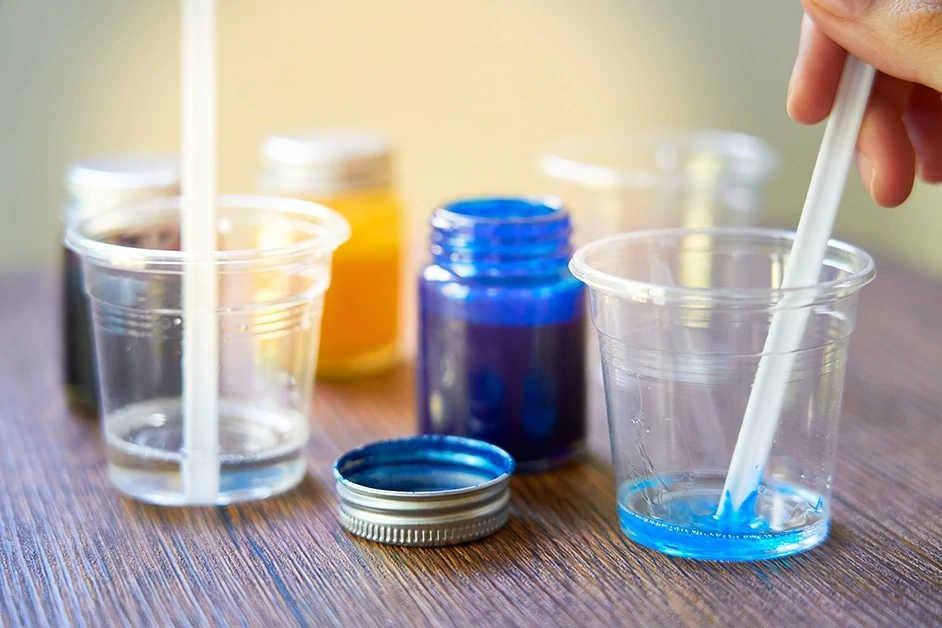
The Curing Times of the different Resins
In general, you can assume that casting resins harden much slower than epoxy resins. While the curing times of cast resins are usually between 36 and 48 hours, epoxy resins cure in periods of about 12 to 24 hours. However, while cast resins often only become viscous and hard after about 24 hours, the thickening of the consistency of epoxy resins can often begin after about 20 minutes. Due to the slower radiation of the heat generated during curing, casting resins can be cast in much thicker layers than epoxy resins.
If you use mixed resin only gradually in portions, the residual quantities in the mixing container can react and harden more quickly due to the heat accumulation.
Tip: The maximum layer thicknesses of individual products should be meticulously observed in each case. Should you pour thicker layers than recommended, extensive projects such as an Epoxy River Table can be ruined by excessive heat development.
The Hardness of Epoxy Resin Surfaces
Not always, but quite often, you can assume that epoxy resins are harder than casting resins due to their nature. However, you can often change the mixing ratio of the cast resins to achieve different degrees of hardness. For example, you can mix casting resin, which can look deceptively real as artificial water in a vase.
If a very hard casting resin is used in this type of application, this will cause the vase to break due to the lack of flexibility and the expansion of glass when exposed to heat. However, you can achieve the necessary flexibility of the resin by changing the amount of hardener used. However, as each casting resin can react differently, you should always consult the manufacturer’s instructions for the product.
Tip: Laminating resins generally offer better scratch resistance than many casting resins. Therefore, it is a good idea to finish resin tables or kitchen worktops with an additional layer of laminating resin or a similar scratch-resistant protective lacquer.
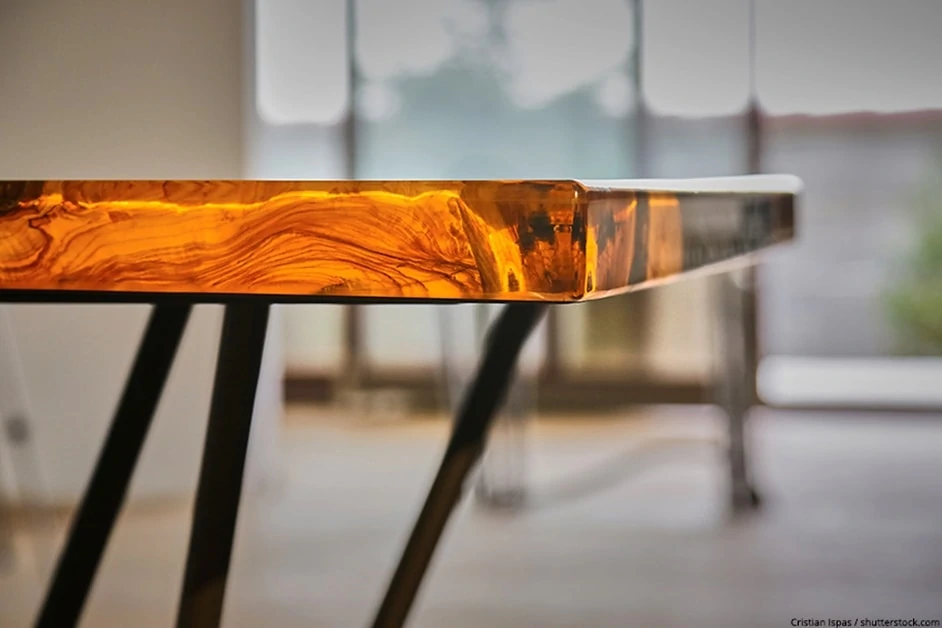
The UV Resistance of various Epoxy Resin Products
There are products already containing high-quality UV stabilizers in both the cast resins and the epoxy resins used for coatings. However, yellowing due to UV radiation is a problem, especially in casting projects of objects and figures with a certain thickness, as the yellowing is more visible due to the lack of a substrate made of wood with the appropriate grain or stain.
Some epoxy resin products are less susceptible than other products to the haze known as yellowing. However, coating epoxies are often less well protected against yellowing, as the appearance of this effect is less dramatic due to the color effects of a translucent substrate. For this reason, we recommend that you do not use special laminating resins for permanent outdoor use or in an indoor area with constant UV radiation through windows.
- 1 : 1 mix ratio by volume (100 A to 83 B by weight)
- Enhanced UV inhibitors to resist yellowing
- Self-leveling, super clear results
Susceptibility to Bubble Formation
Various substrates and objects encapsulated in epoxy resin can cause a certain amount of bubbling in both cast resin and epoxy resin. With cast resin, however, this is sometimes a less serious problem, as the air bubbles can rise more easily and burst on the surface due to the thinner resin.
However, the formation of bubbles can be reduced from the outset with all epoxy resins if you prepare your project carefully. First, you should seal porous wooden surfaces of materials such as wood with a thin layer of epoxy resin. This allows the resin to flow over the porous surfaces and then the air bubbles to rise to the surface of the thin layer of sealant. Objects to be encapsulated should also first be surface sealed before being poured into thicker layers of epoxy resin. This is especially true for objects with many corners, grooves or otherwise finely structured surfaces, as such forms can introduce large amounts of air into the epoxy resin used.
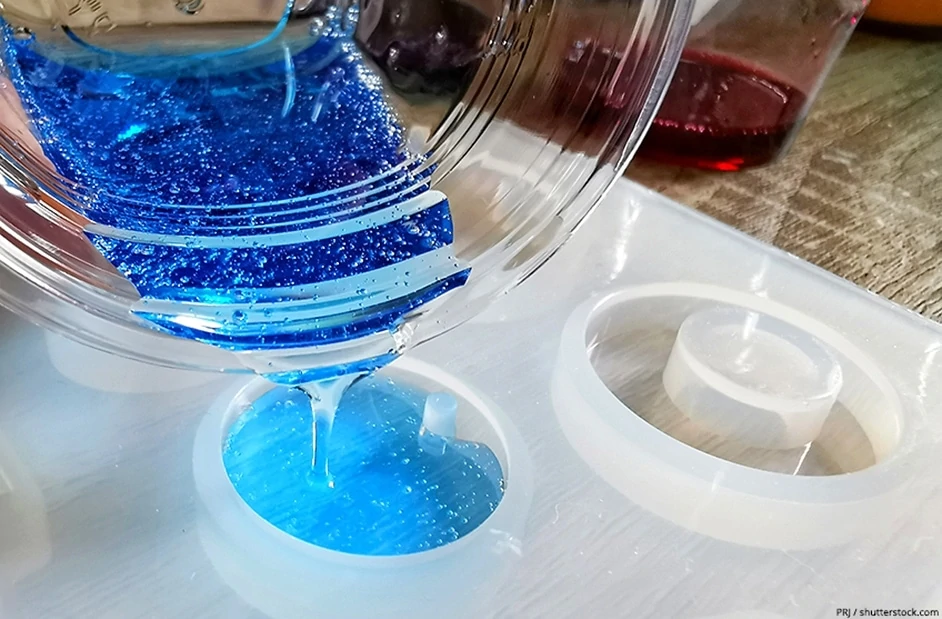
The Heat Compatibility of Epoxy Resin
For some projects you should not just buy any epoxy resin. Special care should be taken with the temperature factor, as the casting resins and epoxy resins used by DIY enthusiasts for various applications are generally not designated high temperature epoxies. This is not least because high-temperature epoxy systems can be quite expensive. Cheaper casting resins and epoxy resins often have the sometimes unpleasant property of becoming soft from a temperature range of 120 to 150 degrees Celsius.
Of course, this is particularly unfavourable if hot coffee cups, pans or saucepans are to be placed on the coated surface of tables, kitchen covers or coasters later on. Even brief contact with hot objects can be sufficient to damage such surfaces. However, Resin Epoxy can easily withstand temperatures well below zero after curing. We made very good experience with the Stone Coat heat resistant TableTop Epoxy, that is one of the only products for home DIY workers.
- Cures in 24 hours, self-leveling
- Heat resistant up to 425°F, crystal clear and UV stable
- Scratch-resistant, food-safe, zero VOC's
You will find heat-resistant epoxy resins in various product variations on the market. While the usual resin products can often only offer short temperature resistance up to about 150 degrees Celsius, these special products from the industrial sector can also withstand heat temperatures up to about 600 degrees Celsius without any problems. This is ensured by a formulation of these resins with fillers such as quartz, which also provides good abrasion resistance.
Coloring Epoxy Resin
You can now buy a wide range of different color pigments, liquid colors and color pastes to match your chosen epoxy. You should only make sure that the colorants do not contain any water. This could lead to unwanted effects when processing the resin. With the right epoxy resin colors, coloring is not a big problem as long as you follow the manufacturer’s instructions on dosage.
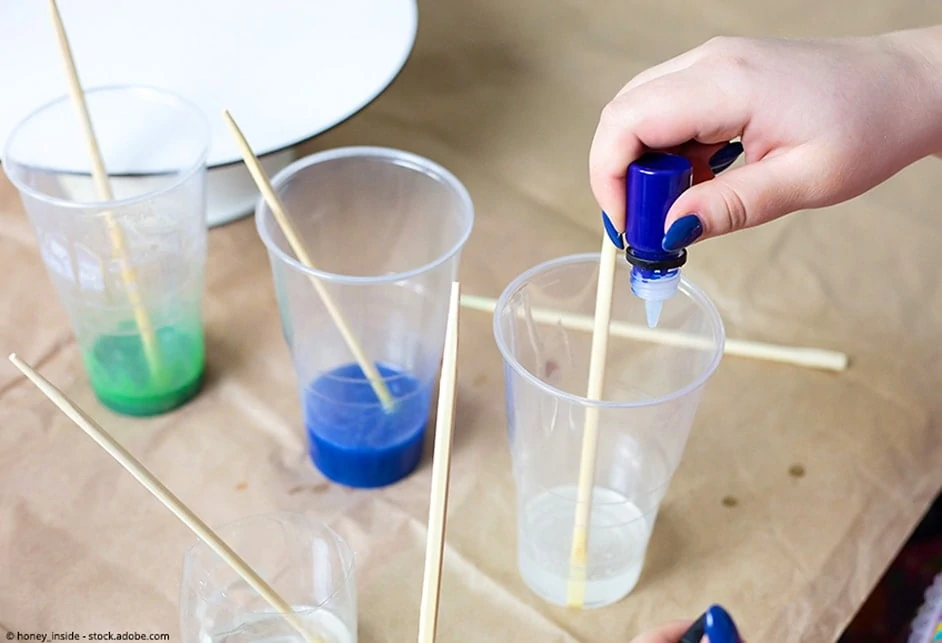
Information on weighing and mixing Resin
To ensure that you can look forward to a perfect end result after the completion of your project, you should strictly adhere to the mixing ratios recommended for certain products. With most resin systems, this is ensured by weighing with a scale. You should start mixing the two components as soon as possible after pouring them into the mixing container and you should mix the components very carefully for at least 2 minutes.
Saving sticky Resin Surfaces
Actually, even slowly curing resin should have a firmly cured surface after a few days at the latest. Sometimes, however, something goes wrong and it happens that the surface still feels sticky even after several days. The reasons for this can be many and varied: Perhaps the product used had already passed its sell-by date, it was processed under suboptimal environmental conditions or you were a little off in the mixing ratio. In the separate text on mixing epoxy resin, you will find more information on what may have gone wrong and how to avoid it in the future. Even with a sticky surface, you don’t have to write off a project completely.
With the following measures you can save your project in such a case:
- In a first step you should scrape off as much of the sticky resin as possible and discard it.
- After removing the sticky resin, surface defects such as craters and holes can be filled and corrected with newly mixed resin in the appropriate areas.
- After hardening, you should then lightly sand down not only the patched area, but the entire resin workpiece.
- Then the dust created during sanding is wiped off thoroughly so that a second layer of resin can be applied.
- It’s quite possible that your project will look completely failed after being repaired and sanded. But you should not be put off by this. If you do everything right when applying the second layer, you can still achieve a perfect result without any sticky surfaces.
The right Painting Surface for Resin Art
In general it can be said that resin can be cast on all appropriately cleaned and grease-free surfaces. For the production of your own resin art paintings we recommend the use of wood painting grounds. These are particularly suitable for Resin Art because, unlike canvas, they do not sag under the weight of the resin.
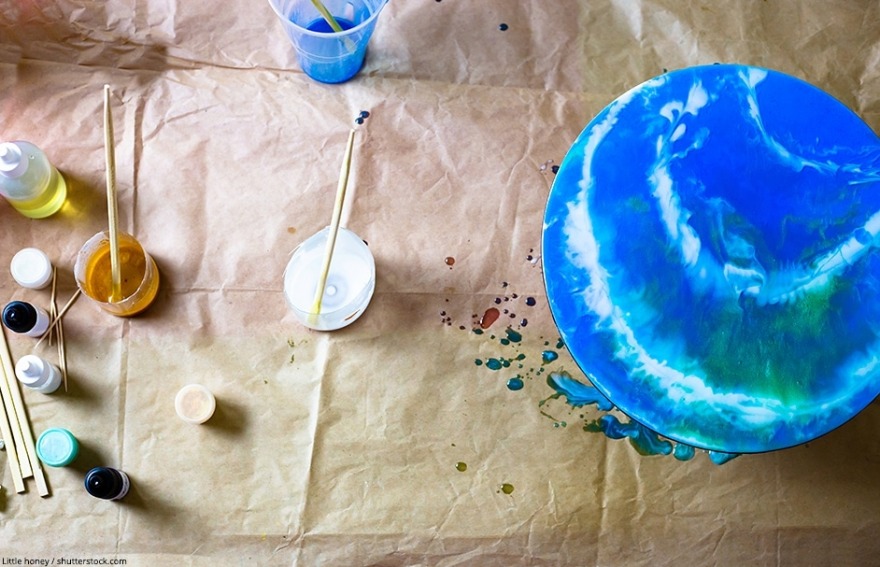
Buying Epoxy Resin: Frequently asked Questions and Answers on the Topic
At this point we list some of the most frequently asked questions and the corresponding answers.
Where is the cheapest place to buy Epoxy Resin?
Ordering via the Internet is particularly quick and easy, as you can buy the epoxy resin that perfectly matches your project from a particularly large selection of product variants and brands. Since you can buy epoxy resin at relatively low prices on the Internet, you can also focus even more on products with specific product characteristics.
What quantities of Epoxy Resin should I order for my planned Project?
We are happy to help you calculate the amount of epoxy resin/resin you need. You can easily use the epoxy resin calculator which has been specially programmed for this purpose.
Which dyes are suitable for coloring Epoxy Resin?
Meanwhile, there is a wide range of possible colorants available for epoxy resin coloring: You are spoilt for choice between Alcohol Inks, pigments, airbrush paints and special color pastes for epoxy resin.
How do I mix the Epoxy Resin components?
Mixing the two components is a very important step in the processing of epoxy resin. Only if you mix the components very carefully and evenly can your material ultimately cure optimally. Details and helpful tips on this important step can also be found in our separate article on mixing epoxy resin.
In 2005, Charlene completed her wellness degrees in therapeutic aromatherapy and reflexology at the International School of Reflexology and Meridian Therapy. She worked for a company offering corporate wellness programs for several years before opening her own therapy practice. In 2015, she was asked by a digital marketer friend to join her company as a content creator, and it was here that she discovered her enthusiasm for writing. Since entering the world of content creation, she has gained a lot of experience over the years writing about various topics such as beauty, health, wellness, travel, crafting, and much more. Due to various circumstances, she had to give up her therapy practice and now works as a freelance writer. Since she is a very creative person and as a balance to writing likes to be active in various areas of art and crafts, the activity at acrylgiessen.com is perfect for her to contribute their knowledge and experience in various creative topics.
Learn more about Charlene Lewis and about us.
